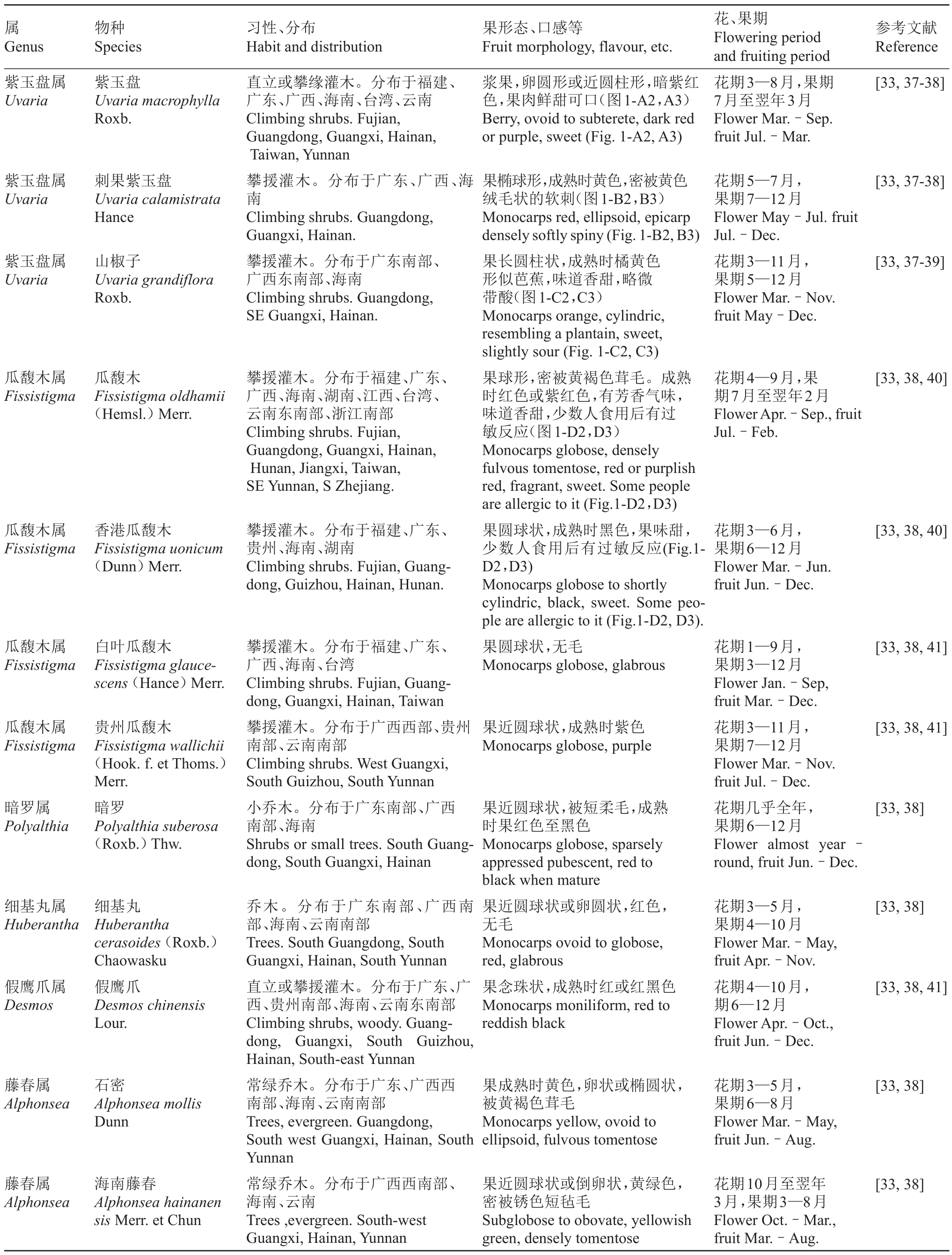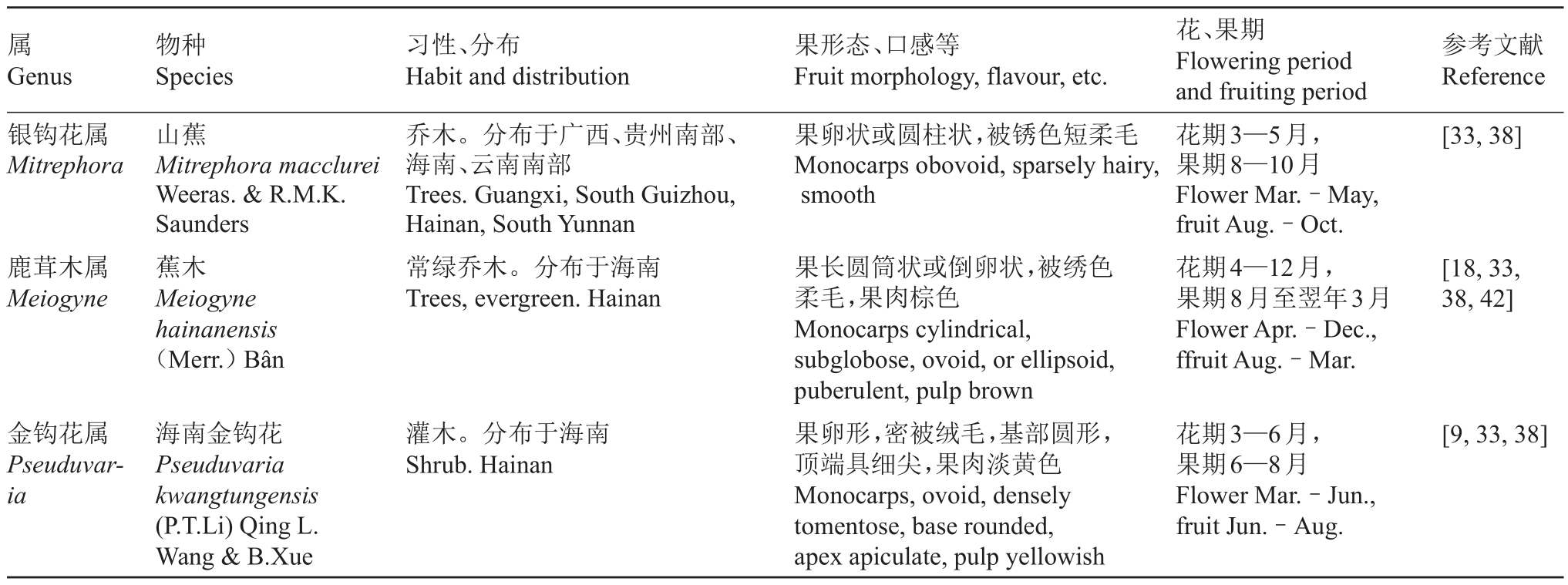水果是满足人类机体活动的重要营养物质来源,并且具有抗氧化、消除自由基、防癌、抗菌消炎和抗过敏等活性作用,其富含维生素、花色素、黄酮类等功能性成分,为人体提供基本的营养物质外还具有健康功效[1]。许多未经人类规模栽培且未形成商品生产的野生水果[2],具有种类繁多、量大、味美、抗性强、耐贫瘠、果色多样等优点[3],并且营养价值(蛋白质、脂肪、糖类、维生素和各种矿质元素等营养素)高于栽培水果,营养物质多样,药用价值高[4]。随着生活水平的提高,越来越多的野生水果受到人们的关注和喜爱。
可见,野生水果有着广阔的开发前景和重要的利用价值,既可直接开发利用,也可作为育种材料培育出新一代水果[5],同样也是众多水果栽培品种种质资源改良的重要基因库。
番荔枝科在我国有着较为丰富的水果资源,但尚未得到很好的开发利用。目前主要的开发利用体现在一部分为少数人野外采摘食用或者量多时拿去销售,销售价格昂贵;一部分为植物园或者园艺公司栽培,也有少数人自己种植食用。关于番荔枝科植物的研究目前主要集中于分类学[6-18]、系统发育[17-22]、繁殖生物学[23-26]、植物化学[27-29]等方面,另有少数涉及栽培技术和繁殖技术等方面的研究;而对其果实的主要营养成分、生物活性成分和产品开发等方面研究还较少。笔者充分检索、查阅文献,了解前人对番荔枝科野生水果的调查、研究相关的成果材料,对番荔枝科野生水果资源研究现状及存在问题进行综述,并对其开发前景进行展望,旨在为番荔枝科野生水果资源的开发利用和精深加工提供研发思路。
1 番荔枝科概况
番荔枝科(Annonaceae)隶属于木兰纲木兰目(Magnoliales),是该目最大的一个科,是低地热带雨林中生态系统的重要组成成分[30-31]。番荔枝科目前被界定为4 个亚科,共约110 属,2400 余种[21, 32]。产于全球热带和亚热带地区,另有一属巴婆果属(Asimina Adans.)产于温带地区。我国有25 属,120种及6变种,主要分布于西南部至台湾,大部分产华南,少数分布于华东[33]。该科植物大部分果实可食用,我国水果市场上常见的番荔枝科水果以番荔枝属(Annona L.)为主,如不同品种的番荔枝(Annona squamosa L.)、刺果番荔枝(Annona muricata L.)、牛心番荔枝(Annona reticulata L.)等;另外北美地区还有巴婆果(Asimina triloba Dunal)及其加工产品如冰淇淋等,目前该种在中国武汉植物园和杭州植物园等有引种栽培。
2 番荔枝科野生水果资源
番荔枝科植物在我国分布广泛,虽然种类不多,但其水果资源较为丰富,不少种类在水果资源方面具有良好的研究价值与开发前景。吴志敏等[35]曾对广东省野生水果植物资源进行调查,其中涉及番荔枝科植物7 种:假鹰爪(Desmos chinensis Lour.)、瓜馥木[Fissistigma oldhamii(Hemsl.)Merr.]、白叶瓜馥木[Fissistigma glaucescens(Hance)Merr.]、香港瓜馥木[Fissistigma uonicum(Dunn)Merr.]、细基丸[Huberantha cerasoides(Roxb.)Chaowasku]、暗 罗[Polyalthia suberosa(Roxb.)Thw.]、紫玉盘(Uvaria macrophylla Roxb.)。之后,王云生等[36]在对中国野生水果类群的资料整理中收录番荔枝科4属7种,包括藤春属(Alphonsea Hook.f.&Thomson)、假鹰爪属(Desmos Lour.)、暗罗属(Polyalthia Blume)、紫玉盘属(Uvaria L.)。番荔枝科野生水果营养丰富,王秀丽等[37]对山椒子(Uvaria grandiflora Roxb.)的果实营养成分进行了研究,结果发现其果实中氨基酸种类齐全,检测到17种氨基酸,其中7种为人体必需氨基酸。经查阅相关资料和野外考察,筛选出15种具有开发潜力的番荔枝科野生水果(表1)。
表1 国内较有开发前景的番荔枝科野生水果一览表
Table 1 List of wild fruits of Annonaceae with utilization potential in China

属Genus物种Species习性、分布Habit and distribution果形态、口感等Fruit morphology,flavour,etc.花、果期Flowering period and fruiting period参考文献Reference紫玉盘属Uvaria紫玉盘Uvaria macrophylla Roxb.紫玉盘属Uvaria刺果紫玉盘Uvaria calamistrata Hance紫玉盘属Uvaria山椒子Uvaria grandiflora Roxb.瓜馥木属Fissistigma瓜馥木Fissistigma oldhamii(Hemsl.)Merr.瓜馥木属Fissistigma香港瓜馥木Fissistigma uonicum(Dunn)Merr.瓜馥木属Fissistigma白叶瓜馥木Fissistigma glaucescens(Hance)Merr.瓜馥木属Fissistigma暗罗属Polyalthia贵州瓜馥木Fissistigma wallichii(Hook.f.et Thoms.)Merr.暗罗Polyalthia suberosa(Roxb.)Thw.细基丸属Huberantha假鹰爪属Desmos细基丸Huberantha cerasoides(Roxb.)Chaowasku假鹰爪Desmos chinensis Lour.藤春属Alphonsea石密Alphonsea mollis Dunn藤春属Alphonsea海南藤春Alphonsea hainanen sis Merr.et Chun直立或攀缘灌木。分布于福建、广东、广西、海南、台湾、云南Climbing shrubs.Fujian,Guangdong,Guangxi,Hainan,Taiwan,Yunnan攀援灌木。分布于广东、广西、海南Climbing shrubs.Guangdong,Guangxi,Hainan.攀援灌木。分布于广东南部、广西东南部、海南Climbing shrubs.Guangdong,SE Guangxi,Hainan.浆果,卵圆形或近圆柱形,暗紫红色,果肉鲜甜可口(图1-A2,A3)Berry,ovoid to subterete,dark red or purple,sweet(Fig.1-A2,A3)花期3—8月,果期7月至翌年3月Flower Mar.–Sep.fruit Jul.–Mar.[33,37-38]果椭球形,成熟时黄色,密被黄色绒毛状的软刺(图1-B2,B3)Monocarps red,ellipsoid,epicarp densely softly spiny(Fig.1-B2,B3)果长圆柱状,成熟时橘黄色形似芭蕉,味道香甜,略微带酸(图1-C2,C3)Monocarps orange,cylindric,resembling a plantain,sweet,slightly sour(Fig.1-C2,C3)果球形,密被黄褐色茸毛。成熟时红色或紫红色,有芳香气味,味道香甜,少数人食用后有过敏反应(图1-D2,D3)Monocarps globose,densely fulvous tomentose,red or purplish red,fragrant,sweet.Some people are allergic to it(Fig.1-D2,D3)果圆球状,成熟时黑色,果味甜,少数人食用后有过敏反应(Fig.1-D2,D3)Monocarps globose to shortly cylindric, black, sweet.Some people are allergic to it(Fig.1-D2,D3).果圆球状,无毛Monocarps globose,glabrous花期5—7月,果期7—12月Flower May–Jul.fruit Jul.–Dec.花期3—11月,果期5—12月Flower Mar.–Nov.fruit May–Dec.[33,37-38][33,37-39]攀援灌木。分布于福建、广东、广西、海南、湖南、江西、台湾、云南东南部、浙江南部Climbing shrubs.Fujian,Guangdong,Guangxi,Hainan,Hunan,Jiangxi,Taiwan,SE Yunnan,S Zhejiang.花期4—9月,果期7月至翌年2月FlowerApr.–Sep.,fruit Jul.–Feb.[33,38,40]攀援灌木。分布于福建、广东、贵州、海南、湖南Climbing shrubs.Fujian,Guangdong,Guizhou,Hainan,Hunan.花期3—6月,果期6—12月Flower Mar.–Jun.fruit Jun.–Dec.[33,38,40]攀援灌木。分布于福建、广东、广西、海南、台湾Climbing shrubs.Fujian,Guangdong,Guangxi,Hainan,Taiwan攀援灌木。分布于广西西部、贵州南部、云南南部Climbing shrubs.West Guangxi,South Guizhou,South Yunnan小乔木。分布于广东南部、广西南部、海南Shrubs or small trees.South Guangdong,South Guangxi,Hainan[33,38,41]果近圆球状,成熟时紫色Monocarps globose,purple花期1—9月,果期3—12月Flower Jan.–Sep,fruit Mar.–Dec.花期3—11月,果期7—12月Flower Mar.–Nov.fruit Jul.–Dec.花期几乎全年,果期6—12月Flower almost year –round,fruit Jun.–Dec.[33,38,41][33,38]乔木。分布于广东南部、广西南部、海南、云南南部Trees.South Guangdong,South Guangxi,Hainan,South Yunnan直立或攀援灌木。分布于广东、广西、贵州南部、海南、云南东南部Climbing shrubs,woody.Guangdong, Guangxi, South Guizhou,Hainan,South-east Yunnan常绿乔木。分布于广东、广西西南部、海南、云南南部Trees,evergreen.Guangdong,South west Guangxi, Hainan, South Yunnan常绿乔木。分布于广西西南部、海南、云南Trees,evergreen.South-west Guangxi,Hainan,Yunnan果近圆球状,被短柔毛,成熟时果红色至黑色Monocarps globose,sparsely appressed pubescent,red to black when mature果近圆球状或卵圆状,红色,无毛Monocarps ovoid to globose,red,glabrous果念珠状,成熟时红或红黑色Monocarps moniliform,red to reddish black花期3—5月,果期4—10月Flower Mar.–May,fruit Apr.–Nov.花期4—10月,期6—12月Flower Apr.–Oct.,fruit Jun.–Dec.[33,38][33,38,41]果成熟时黄色,卵状或椭圆状,被黄褐色茸毛Monocarps yellow,ovoid to ellipsoid,fulvous tomentose花期3—5月,果期6—8月Flower Mar.–May,fruit Jun.–Aug.[33,38]果近圆球状或倒卵状,黄绿色,密被锈色短毡毛Subglobose to obovate,yellowish green,densely tomentose花期10月至翌年3月,果期3—8月Flower Oct.–Mar.,fruit Mar.–Aug.[33,38]
续表Continued Table

属Genus物种Species习性、分布Habit and distribution果形态、口感等Fruit morphology,flavour,etc.花、果期Flowering period and fruiting period参考文献Reference银钩花属Mitrephora果卵状或圆柱状,被锈色短柔毛Monocarps obovoid,sparsely hairy,smooth[33,38]鹿茸木属Meiogyne山蕉Mitrephora macclurei Weeras.&R.M.K.Saunders蕉木Meiogyne hainanensis(Merr.)Bân乔木。分布于广西、贵州南部、海南、云南南部Trees.Guangxi,South Guizhou,Hainan,South Yunnan常绿乔木。分布于海南Trees,evergreen.Hainan花期3—5月,果期8—10月Flower Mar.–May,fruit Aug.–Oct.花期4—12月,果期8月至翌年3月Flower Apr.–Dec.,ffruit Aug.–Mar.[18,33,38,42]金钩花属Pseuduvaria海南金钩花Pseuduvaria kwangtungensis(P.T.Li)Qing L.Wang&B.Xue灌木。分布于海南Shrub.Hainan果长圆筒状或倒卵状,被绣色柔毛,果肉棕色Monocarps cylindrical,subglobose,ovoid,or ellipsoid,puberulent,pulp brown果卵形,密被绒毛,基部圆形,顶端具细尖,果肉淡黄色Monocarps,ovoid,densely tomentose,base rounded,apex apiculate,pulp yellowish花期3—6月,果期6—8月Flower Mar.–Jun.,fruit Jun.–Aug.[9,33,38]
3 开发现状、问题及解决方法
3.1 开发现状
现阶段,番荔枝科野生水果以鲜食为主。在野生水果自然成熟期,其产地一些百姓采摘鲜食,果实产量较大时拿到市面售卖。如福建地区,有较多的野生香港瓜馥木和瓜馥木[43],当地百姓会上山采摘,当地市场偶见;江西赣州地区也有较多野生瓜馥木,果实被采摘鲜食。在广东地区,野生比较多的是紫玉盘和山椒子,多为当地百姓或植物爱好者野外采摘食用。广西钦州地区有较多的紫玉盘和山椒子,常被一些百姓挖取植株,移栽种植,以卖植株为主,售卖果实为辅。
3.2 存在问题及解决方法
目前,番荔枝科野生水果资源总体虽然丰富,但对番荔枝科野生水果的种类、居群大小及分布、营养成分组成、市场需求等尚未了解清楚,研究力度小,尚未得到有效的开发利用。现总结其中存在的问题,并提出相应的解决方法。
3.2.1 采收不当 当地百姓缺乏可持续利用意识,采收方式不当。番荔枝科植物为攀援状灌木或乔木,野外生长多在较高处结实,给采摘带来不便。因此,大部分人采摘会将植株砍伐或折断,对植物造成损伤。加强番荔枝科知识的科普及宣传力度,倡导可持续利用意识尤为重要。
3.2.2 无产业化 目前番荔枝科野生水果停留在当地百姓采摘阶段,既没有产业化,也没有加工成系列产品。所以加快对番荔枝科野生水果开发、育种、栽培标准化、采后贮藏等的研究,是形成产业化和加工成系列产品的重要因素。
3.2.3 生境破坏 番荔枝科植物多生长在山地密林或疏林中,人为开发森林,破坏了生境,使得番荔枝科大多数野生资源受到威胁[44]。此外,有不少当地百姓挖取番荔枝科野生资源,移栽回家种植,这也给野生种质资源的保护带来一定的困难。保护动植物的生境是刻不容缓的责任和义务,不仅仅局限于对番荔枝科野生植物的保护。
3.2.4 果实少、种子多 番荔枝科花部传粉室可分为开放型、半闭合型和闭合型3类,主要传粉者为蜂类、蝇类及蓟马[45],大多数的属果实为肉质不开裂浆果[46]。然而,因其特殊花部结构和特定传粉者,番荔枝科大部分植物在野生状态下授粉率低,结实率低,处于自生自灭的状态,资源分散。授粉率低是果实少的一方面原因,另一方面原因是坐果率低。通过人工授粉可以解决授粉率低的问题,提高坐果率。
虽然番荔枝科的野生水果营养丰富、果肉美味,但是种子多、可食率低成为野生水果开发的一大难点。建议首先通过选育野生状态下种子少的植株进行无性繁殖或进行杂交选育;其次可以利用外源激素处理[47]、物理诱变[48]、化学诱变[48]等方法进行无籽育种。人们日常食用的众多水果,大部分也是从野生状态下经过漫长的选育、杂交育种、倍性育种[49]才最终实现商品化的。此外,将来待时机成熟,全基因组关联分析(GWAS)和基因组选择(GS)育种[50]、分子标记无融合生殖育种[51]、CRISPR/Cas9 基因编辑系统定点编辑育种[52-53]等也是未来可尝试的育种手段。
4 番荔枝科水果的繁殖、栽培及育种研究
国外关于番荔枝科水果繁殖、栽培及育种主要针对番荔枝属和巴婆果属,特别是番荔枝和巴婆果,集中在无性繁殖[54-56]、杂交[57-59]、无籽[60]、分子标记[61]等方面。其中,无性繁殖主要是微繁殖和再生体系建立。杂交是通过筛选具有优良性状的亲本进行杂交[57-59]。无籽育种中一方面是寻找无籽型的自然突变体[60],发现无籽性状的原因是INO 位点缺失[60],从而在微繁殖和遗传转化中,利用RNA 干扰对INO基因沉默[61];另一方面是利用γ辐射或秋水仙素获得四倍体,然后通过四倍体与二倍体杂交产生无核三倍体[57]。应用分子标记将感兴趣的性状与基因组相结合,更多的是用于优化植物遗传资源管理[61]。而国内关于番荔枝科水果资源繁殖、栽培方面的研究不多,主要在番荔枝属、紫玉盘属、巴婆果属中有相关研究,集中在嫁接技术中砧木的选取[62-63]、外界条件(外源激素[64-65]、温度[66]、土壤基质[35])对种子萌发率的影响、离体植株再生的最适条件[67]等方面,研究的种类较少,方向较窄,而育种方面的研究更是鲜有涉及。
番荔枝科大部分的野生水果资源繁殖采用种子播种方式为主[42,68-69],对温度和水分需求敏感。部分采用扦插、压条方式繁殖[70],如假鹰爪。番荔枝科种子为顽拗性种子,播种以后萌发缓慢;大部分种类枝条木质化程度高,扦插不易成活。因此,对于不同种的繁殖方式,视具体种而定。对于实生苗的繁殖,应根据种自身的特性,采用不同的方法收集种子,如通过现收现播,或加以沙藏[42,68-69]。探讨种子适宜的保存条件及萌发条件,提高种子萌发率。对于无性繁殖,探讨扦插、压条、嫁接的存活情况,选择适合的方式繁殖;对于离体组织培养,探讨最佳的组培条件及离体培养部位的选取。无论是在番荔枝科中,还是其他科果树的育种、繁殖及栽培,寻找适宜、恰当的育种手段、繁殖方式、栽培技术都显得非常重要。探索的过程尽管很漫长和艰辛,但这是突破关键点的必经过程。
5 开发前景
5.1 特色水果开发
对挑选采集的番荔枝科野生水果进行营养成分测定,分析碳水化合物、脂类、蛋白质、氨基酸、维生素、矿物质、微量元素等成分的含量。对结果进行分析,并与普通常见水果包括番荔枝科中已开发并市场化的番荔枝属水果进行比较,根据营养成分进行评价,并依据果实大小、质量及风味等测评标准,挑选多种具潜力可开发的野生水果,如比较常见的紫玉盘(果肉香甜可口;图1-A2,A3)、山椒子(口感清甜;图1-C2,C3)、瓜馥木(味甜;图1-D2,D3)。

图1 中国番荔枝科部分野生水果
Fig.1 Some wild fruits of Annonaceae in China
A1~A3.紫玉盘;B1~B3.刺果紫玉盘;C1~C3.山椒子;D1~D3.瓜馥木。
A1-A3.Uvaria macrophylla Roxb.;B1-B3.Uvaria calamistrata Hance;C1-C3.Uvaria grandiflora Roxb.;D1-D3.Fissistigma oldhamii(Hemsl.)Merr.
5.2 提取天然色素
天然色素种类繁多,具有多种功效。在食品、药用、化妆品上具有广阔的应用前景。番荔枝科大部分野生水果天然色素丰富,如黄色的山椒子(图1-C2)、刺果紫玉盘(图1-B2)、紫色的紫玉盘(图1-A2)、假鹰爪、香港瓜馥木、暗罗;红色的细基丸、瓜馥木(图1-D2)等。可对果肉或果皮进行分离,提取浓缩,分析色素成分及功效,开发成天然食品添加剂等多种用途。
5.3 驯化引种
由于番荔枝科野生水果具有资源分散、产量低、质量不稳、采收难等缺点,因此有必要对一些营养价值高、开发潜力大、野外分布少的种类进行引种驯化。一方面通过引种驯化稳定产量,改善野生果实的品质,使得口感和风味等满足市场需求,促进经济的发展;另一方面可以有效保护野生种质资源库,为遗传育种提供材料。此外,番荔枝科野生水果中的一些攀援灌木种类,可开发作为林下经济植物[71],如山椒子、紫玉盘、假鹰爪等。
5.4 保存具有优良抗性基因的亲本材料
野生果树在长期的自然选择下保留着强大的适应性和抗逆性基因,具有丰富的遗传多样性[72]。通过研究番荔枝科野生果树种质资源的多样性、抗性及亲和性,利用性状优良的番荔枝科野生水果资源作为杂交亲本材料,选育出更优良的品种类型。
5.5 开发为园林绿化植物
番荔枝科大部分野生果树花朵颜色艳丽(图1-A1,C1)、气味芬芳、果实奇特(图1-A2,B2,C2,D2),如山椒子花朵大,紫红色或深红色,艳丽而脱俗(图1-C1),果实成熟时如一大串金黄色香蕉(图1-C2);紫玉盘花朵暗紫红或淡红褐色,花小而精巧(图1-A1),果实成熟时紫色至紫黑色(图1-A2);假鹰爪花黄白色,花开时满树皆花,花香味浓郁持久,果实成熟时呈紫黑色,似一串串小冰糖葫芦。番荔枝科植物大部分花期和果期较长,全年可供观赏,在园林中可直接应用,充分发挥其观赏作用。也可使其矮化,形成观赏与食用共享的野果盆景。
6 展 望
总而言之,中国番荔枝科野生水果资源丰富,开发潜力大,利用价值高。可加强番荔枝科野生资源保护、引种驯化、繁殖、栽培、育种技术及果实生物活性成分等方面的研究。通过各学科交叉研究,挖掘番荔枝科不同物种的价值,使其充分发挥不同的功能,在食用、药用、材用、绿化等方面发挥其经济、社会、生态方面等多重效益。
致谢:感谢袁浪兴、王清隆、康宁、刘苑容提供照片;感谢叶幸儿提出宝贵修改意见。
[1]周丹蓉,廖汝玉,叶新福.水果中主要功能性成分研究进展[J].福建农业学报,2011,26(6):1129-1134.ZHOU Danrong,LIAO Ruyu,YE Xinfu.A review for researches of main functional components in fruit[J].Fujian Journal of Agricultural Sciences,2011,26(6):1129-1134.
[2]梁佰华,潘秋荣,韦春梅.广东东源康禾省级自然保护区野生水果植物资源调查[J].亚热带植物科学,2012,41(3):56-60.LIANG Baihua,PAN Qiurong,WEI Chunmei.An investigation of wild fruit plant resources in of Dongyuan Kanghe Provincial Nature Reserve,Guangdong Province[J].Subtropical Plant Science,2012,41(3):56-60.
[3]鲍晓华.普洱市思茅区常见野生水果资源及开发利用[J].中国林副特产,2008(2):66-68.BAO Xiaohua.Common wild fruit resources utilization in Simao District of Pu’er City[J].Forest By-Products and Speciality in China,2008(2):66-68.
[4]张福平,张秋燕,陈蔚辉,张桂充,郑巽.野生水果资源的利用与保护[J].中国食物与营养,2003(5):28-29.ZHANG Fuping,ZHANG Qiuyan,CHEN Weihui,ZHANG Guichong,ZHENG Xun.Utilization and protection of wild fruit resources[J].Food and Nutrition in China,2003(5):28-29.
[5]侯方.澄江野生水果资源及开发利用[J].中国林副特产,2007(2):64-65.HOU Fang.Wild fruit resources and development in Chengjiang[J].Forest By-Products and Speciality in China,2007(2):64-65.
[6]孙同兴,董运秋,侯学良.中国瓜馥木属植物叶片结构的解剖观察[J].广西植物,2017,37(5):572-580.SUN Tongxing,DONG Yunqiu,HOU Xueliang.Comparative anatomy on leaves of Fissistigma (Annonaceae) from China[J].Guihaia,2017,37(5):572-580.
[7]李红芳,张小卉.四种番荔枝科(Annonaceae)植物导管分子及其穿孔板的比较观察[J].广西植物,2018,38(5):665-671.LI Hongfang,ZHANG Xiaohui.Comparative observation on vessel elements and perforation plates in four species of Annonaceae[J].Guihaia,2018,38(5):665-671.
[8]XUE B,TAN Y H,THOMAS D C,CHAOWASKU T,HOU X L,SAUNDERS R M K.A new Annonaceae genus,Wuodendron,provides support for a post-boreotropical origin of the Asian-Neotropical disjunction in the tribe Miliuseae[J].Taxon,2018,67(2):250-266.
[9]WANG Q L,ZHANG H,SHAO Y Y,WANG Z N,XUE B.A second species of Pseuduvaria in China:The identity of the enigmatic species Meiogyne kwangtungensis[J].PhytoKeys,2021,172(1):1-15.
[10]XUE B,SHAO Y Y,SAUNDERS R M K,TAN Y H.Alphonsea glandulosa(Annonaceae),a new species from Yunnan,China[J].PLoS One,2017,12(2):e0170107.
[11]XUE B,WANG G T,ZHOU X X,HUANG Y,TONG Y,LI Y Q,CHEN J.Artabotrys pachypetalus (Annonaceae),a new species from China[J].PhytoKeys,2021,178(2):71-80.
[12]XUE B,YE D P,SHAO Y Y,TAN Y H.Polyalthia yingjiangensis sp.nov (Annonaceae) from the China/Myanmar border[J].Nordic Journal of Botany,2017,35(4):476-481.
[13]XUE B,TAN Y H,YE X E.The identity of Polyalthia florulenta (Annonaceae):A second species of Wangia in China[J].Phytotaxa,2016,283(2):163-171.
[14]XUE B,SUBERKTI N,XU Y,LI Y Q.Excluding the species Monoon fragrans(Annonaceae)from the flora of China[J].Phytotaxa,2021,487(1):91-96.
[15]XUE B,SHAO Y Y,XIAO C F,LIU M F,LI Y Q,TAN Y H.Meiogyne oligocarpa (Annonaceae),a new species from Yunnan,China[J].PeerJ,2021,9:e10999.
[16]谭运洪,陈雨晴,薛彬娥.中国瓜馥木属(番荔枝科)一新记录种[J].热带亚热带植物学报,2017,25(3):285-287.TAN Yunhong,CHEN Yuqing,XUE Bin’e.A newly recorded species of Fissistigma Griffith(Annonaceae)from China[J].Journal of Tropical and Subtropical Botany,2017,25(3):285-287.
[17]XUE B,SU Y C F,THOMAS D C,SAUNDERS R M K.Pruning the polyphyletic genus Polyalthia (Annonaceae) and resurrecting the genus Monoon[J].Taxon,2012,61(5):1021-1039.
[18]XUE B,THOMAS D C,CHAOWASKU T,JOHNSON D M,SAUNDERS R M K.Molecular phylogenetic support for the taxonomic merger of Fitzalania and Meiogyne (Annonaceae):New nomenclatural combinations under the conserved name Meiogyne[J].Systematic Botany,2014,39(2):396-404.
[19]XUE B,GUO X,LANDIS J B,SUN M,TANG C C,SOLTIS P S,SOLTIS D E,SAUNDERS R M K.Accelerated diversification correlated with functional traits shapes extant diversity of the early divergent angiosperm family Annonaceae[J].Molecular Phylogenetics and Evolution,2020,142:106659.
[20]XUE B,SU Y,MOLS J,KESSLER P,SAUNDERS R.Further fragmentation of the polyphyletic genus Polyalthia (Annonaceae):Molecular phylogenetic support for a broader delimitation of Marsypopetalum[J].Systematics and Biodiversity,2011,9(1):17-26.
[21]GUO X,TANG C C,THOMAS D C,COUVREUR T,SAUNDERS R.A mega-phylogeny of the Annonaceae:taxonomic placement of five enigmatic genera and support for a new tribe,Phoenicantheae[J].Scientific Reports,2017,7(1):7323.
[22]THOMAS D C,SURVESWARAN S,XUE B,SANKOWSKY G,MOLS J B,KESSLER P J A,SAUNDERS R M K.Molecular phylogenetics and historical biogeography of the Meiogyne-Fitzalania clade (Annonaceae):Generic paraphyly and late miocene-pliocene diversification in Australasia and the Pacific[J].Taxon,2012,61(3):559-575.
[23]SAUNDERS R M K.The evolution of key functional floral traits in the early divergent angiosperm family Annonaceae[J].Journal of Systematics and Evolution,2020,58(4):369-392.
[24]LAU J Y Y,PANG C,RAMSDEN L,SAUNDERS R M K.Stigmatic exudate in the Annonaceae:Pollinator reward,pollen germination medium or extragynoecial compitum?[J].Journal of Integrative Plant Biology,2017,59(12):881-894.
[25]CHEN J,LIU M F,SAUNDERS R M K.Contrasting floral biology of Artabotrys species (Annonaceae):Implications for the evolution of pollinator trapping[J].Plant Species Biology,2020,35(3):1-14.
[26]LAU J Y Y,GUO X,PANG C C,TANG C,THOMAS D C,SAUNDERS R M K.Time-dependent trapping of pollinators driven by the alignment of floral phenology with insect circadian rhythms[J].Frontiers in Plant Science,2017(8):1119.
[27]朱倩,黄启龙,张春磊,曹征宇.大花紫玉盘的化学成分[J].中国药科大学学报,2019,50(6):666-671.ZHU Qian,HUANG Qilong,ZHANG Chunlei,CAO Zhengyu.Chemical constituents of Uvaria grandiflora [J].Journal of China Pharmaceutical University,2019,50(6):666-671.
[28]周戚,赵婷,吴寿远,付艳辉,陈光英,赵俊杰.鹰爪花中生物碱类成分研究[J].热带亚热带植物学报,2018,26(2):191-196.ZHOU Qi,ZHAO Ting,WU Shouyuan,FU Yanhui,CHEN Guangying,ZHAO Junjie.Studies on the Alkaloids from Artabotrys hexapetalus[J].Journal of Tropical and Subtropical Botany,2018,26(2):191-196.
[29]张杜鹃,齐炼文,张方.圆滑番荔枝树叶提取物的化学成分研究[J].海峡药学,2016,28(5):34-37.ZHANG Dujuan,QI Lianwen,ZHANG Fang.Research on components of extract from leaves ofAnnona glabra L.Annonaceae[J].Strait Pharmaceutical Journal,2016,28(5):34-37.
[30]RICHARDSON J E,CHATROU L W,MOLS J B,ERKENS R H J,PIRIE M D.Historical biogeography of two cosmopolitan families of flowering plants:Annonaceae and Rhamnaceae[J].Philosophical Transactions of the Royal Society B:Biological Sciences,2004,359(1450):1495-1508.
[31]PUNYASENA S W,ESHEL G,MCELWAIN J C.The influence of climate on the spatial patterning of Neotropical plant families[J].Journal of Biogeography,2008,35(1):117-130.
[32]CHATROU L W,PIRIE M D,ERKENS R H J,COUVREUR T L P,NEUBIG K M,ABBOTT J R,MOLS J B,MAAS J W,SAUNDERS R M K,CHASE M W.A new subfamilial and tribal classification of the pantropical flowering plant family An-nonaceae informed by molecular phylogenetics[J].Botanical Journal of the Linnean Society,2012,169(1):5-40.
[33]蒋英,李秉滔,吴征镒.中国植物志·番荔枝科[M].北京:科学出版社,1979.JIANG Ying,LI Bingtao,WU Zhengyi.Flora Reipublicae Popularis Sinicae Annonaceae[M].Beijing:Science Press,1979.
[34]吴志敏,李镇魁,冯志坚,李秉滔.广东省野生水果植物资源[J].广西植物,1996(4):308-316.WU Zhimin,LI Zhenkui,FENG Zhijian,LI Bingtao.Resources of the wild fruit plant in Guangdong Province[J].Guihaia,1996(4):308-316.
[35]王云生,陈兴,王如冰.我国野生果树种类的地理分布态势[J].贵州农业科学,2016,44(8):6-10.WANG Yunsheng,CHEN Xing,WANG Rubing.Geographical distribution pattern of wild fruit tree species in China[J].Guizhou Agricultural Sciences,2016,44(8):6-10.
[36]王秀丽,韩维栋,陈杰,莫定鸣.山椒子果实营养成分分析及其种子育苗试验[J].热带农业科学,2013,33(1):20-24.WANG Xiuli,HAN Weidong,CHEN Jie,MO Dingming.Nutritional components of Uvaria grandiflora fruit and breeding methods[J].Chinese Journal of Tropical Agriculture,2013,33(1):20-24.
[37]徐社金,陈健.岭南果树图谱[M].广州:广东科技出版社,2017.XU Shejin,CHEN Jian.Illustration of fruit trees in Lingnan[M].Guangzhou:Guangdong Science and Technology Press,2017.
[38]WU Z Y,RAVEN P H.Flora of China[M].Beijing:Science Press,2011.
[39]杨晓洋.东南亚水果猎人[M].北京:中国农业出版社,2018.YANG Xiaoyang.Fruit hunters in Southeast Asia[M].Beijing:China Agriculture Press,2018.
[40]韦晓霞,王小安,陈文光,吴如健,叶新福.福建省野生果树种质资源圃的建立[J].东南园艺,2019,7(3):46-50.WEI Xiaoxia,WANG Xiaoan,CHEN Wenguang,WU Rujian,YE Xinfu.Establishment of wild fruit tree germplasm repository in Fujian[J].Southeast Horticulture,2019,7(3):46-50.
[41]刑福武,余明恩.深圳野生植物[M].北京:中国林业出版社,2000.XING Fuwu,YU Ming’en.Wild plants of Shenzhen[M].Beijing:Chinese Forestry Publishing House Press,2000.
[42]梁建平.广西珍稀濒危树种[M].南宁:广西科学技术出版社,2001.LIANG Jianping.Rare and endangered tree species in Guangxi[M].Nanning:Guangxi Science and Technology Press,2001.
[43]韦晓霞,叶新福,余文权.福建省野生果树图志[M].北京:中国农业科学技术出版社,2019.WEI Xiaoxia,YE Xinfu,YU Wenquan.Wild fruit trees in Fujian province[M].Beijing:Chinese Agricultural Science and Technology Press,2019.
[44]覃海宁,杨永,董仕勇,何强,贾渝,赵莉娜,于胜祥,刘慧圆,刘博,严岳鸿,向建英,夏念和,彭华,李振宇,张志翔,何兴金,尹林克,林余霖,刘全儒,侯元同,刘演,刘启新,曹伟,李建强,陈世龙,金效华,高天刚,陈文俐,马海英,耿玉英,金孝锋,常朝阳,蒋宏,蔡蕾,臧春鑫,武建勇,叶建飞,赖阳均,刘冰,林秦文,薛纳新.中国高等植物受威胁物种名录[J].生物多样性,2017,25(7):696-744.QIN Haining,YANG Yong,DONG Shiyong,HE Qiang,JIA Yu,ZHAO Lina,YU Shengxiang,LIU Huiyuan,LIU Bo,YAN Yuehong,XIANG Jianying,XIA Nianhe,PENG Hua,LI Zhenyu,ZHANG Zhixiang,HE Xingjin,YIN Linke,LIN Yulin,LIU Quanru,HOU Yuantong,LIU Yan,LIU Qixin,CAO Wei,LI Jianqiang,CHEN Shilong,JIN Xiaohua,GAO Tiangang,CHEN Wenli,MA Haiying,GENG Yuying,JIN Xiaofeng,CHANG Chaoyang,JIANG Hong,CAI Lei,ZANG Chunxin,WU Jianyong,YE Jianfei,LAI Yangjun,LIU Bing,LIN Qinwen,XUE Naxin.Threatened species list of China’s higher plants[J].Biodiversity Science,2017,25(7):696-744.
[45]成梅,徐凤霞.番荔枝科(Annonaceae)传粉室类型及其演化意义[J].广西植物,2020,40(1):60-70.CHENG Mei,XU Fengxia.Classification of pollination chamber and evolution significance of Annonaceae[J].Guihaia,2020,40(1):60-70.
[46]李德铢.植物系统学[M].北京:高等教育出版社,2012.LI Dezhu.Plant Systematics[M].Beijing:Higher Education Press,2012.
[47]赵文杰,师姚妮,刘飞,王丽君,余福山,张玲玲,杨旭武.葡萄无籽化早熟多效剂在巨峰系葡萄上的应用[J].中外葡萄与葡萄酒,2010(1):49-50.ZHAO Wenjie,SHI Yaoni,LIU Fei,WANG Lijun,YU Fushan,ZHANG Lingling,YANG Xuwu.Application of seedless and early ripening agent on Jufeng grape [J].Sino-Overseas Grapevine&Wine,2010(1):49-50.
[48]李泽明,肖玉洁,胡日生,朱列书.诱变育种突变体的鉴定与筛选研究进展[J].农技服务,2017,34(11):10-19.LI Zeming,XIAO Yujie,HU Risheng,ZHU Lieshu.Research progress in identification and screening of mutagenesis breeding mutants[J].Agricultural Technology Service,2017,34(11):10-19.
[49]苏永全,王志伟,任凯丽.二倍体西瓜无籽化生产技术[J].甘肃农业科技,2020(11):84-86.SU Yongquan,WANG Zhiwei,REN Kaili.Seedless production technology of diploid watermelon[J].Gansu Agricultural Science and Technology,2020(11):84-86.
[50]倪海枝,王引,颜帮国,陈方永.果树基因组辅助育种技术研究现状与展望[J/OL].分子植物育种,2021:1-20[2021-11-08].http://kns.cnki.net/kcms/detail/46.1068.S.20210416.1640.009.html.NI Haizhi,WANG Yin,YAN Bangguo,CHEN Fangyong.Research status and prospects of genomics-assisted breeding technology in fruit trees[J/OL].Molecular Plant Breeding,2021:1-20[2021- 11- 08].http://kns.cnki.net/kcms/detail/46.1068.S.20210416.1640.009.html.
[51]张金青,牛奎举,李玉珠,马晖玲.植物无融合生殖发生因素解析及其在草地早熟禾育种中的应用前景展望[J].草业学报,2021,30(4):205-217.ZHANG Jinqing,NIU Kuiju,LI Yuzhu,MA Huiling.Factors inducing plant apomixis and its potential application in Kentuckybluegrass breeding[J].Acta Prataculturae Sinica,2021,30(4):205-217.
[52]ADEEL Z S,SHANEALI Z S,YASHIKA G,LATA S S,PARKASH D O,XUEYONG L,SHAHID M,ASHWANI P.Engineering abiotic stress tolerance via CRISPR/Cas-mediated genome editing[J].Journal of Experimental Botany,2020,71(2):470-479.
[53]王洁,吴怀通.CRISPR/Cas9 系统介导的基因编辑文库筛选在植物中的应用[J].分子植物育种,2021,19(18):1-10.WANG Jie,WU Huaitong.Application of CRISPR/Cas9 systemmediated gene editing library screening in plants[J].Molecular Plant Breeding,2021,19(18):1-10.
[54]ENCINA C L,MARTIN E C,LOPEZ A A,PADILLA I M G.Biotechnology applied to Annona species:A review[J].Revista Brasileira de Fruticultura,2014,36(spe1):17-21.
[55]PADILLA I M G,ENCINA C L.The use of consecutive micrografting improves micropropagation of cherimoya (Annona cherimola Mill.) cultivars[J].Scientia Horticulturae,2011,129(1):167-169.
[56]RASAI S,GEORGE A P,KANTHARAJAH A S.Tissue culture of Annona spp.(cherimoya,atemoya,sugar apple and soursop):A review[J].Scientia Horticulturae,1995,62(1):1-14.
[57]GEORGE A P,BROADLEY R H,NISSEN R,HAMILL S D,TOPP B.Breeding strategies for atemoya and cherimoya[J].Acta Horticulturae,1999,497(497):255-268.
[58]GEORGE A P,BROADLEY R H,NISSEN R J,HAMILL S D,INSTITUTE Q H.Breeding new varieties of Atemoya (Annona spp.Hybrids)[J].Acta Horticulturae,2002(575):323-328.
[59]GEORGE A P,BROADLEY R,NISSEN R J,HAMILL S.Breeding and selecting new varieties and rootstocks of custard apple (Annona spp.hybrids) in subtropical Australia[J].Acta Horticulturae,2005,694(694):125-128.
[60]LORA J,HERRERO M,HORMAZA J I.Stigmatic receptivity in a dichogamous early-divergent angiosperm species,Annona cherimola (Annonaceae):Influence of temperature and humidity[J].American Journal of Botany,2011,98(2):265-274.
[61]LARRAÑAGA N,HORMAZA J I.Advances in genetic diversity analysis in fruit tree crops[M].Cham:Progress in Botany,Springer International Publishing,2016.
[62]彭松兴,王援泉,黄旭明,杨帅,叶耀雄,陈永辉,王泽槐,谢正生.利用中间砧解决阿蒂莫耶番荔枝与圆滑番荔枝嫁接不亲和试验[J].中国南方果树,2011,40(6):42-44.PENG Songxing,WANG Yuanquan,HUANG Xuming,YANG Shuai,YE Yaoxiong,CHEN Yonghui,WANG Zehuai,XIE Zhengsheng.Solving the graft incompatibility between Annona atemoya and Annona glabra by using intermediate anvil[J].South China Fruits,2011,40(6):42-44.
[63]方仁,安振宇,黄伟雄,白先进,尧金燕,龙兴,周双云,张继.不同砧木对凤梨释迦‘吉夫纳’品种生长发育和果实品质的初步研究[J].西南农业学报,2019,32(10):2398-2402.FANG Ren,AN Zhenyu,HUANG Weixiong,BAI Xianjin,YAO Jinyan,LONG Xing,ZHOU Shuangyun,ZHANG Ji.Effects of different rootstock on growth and fruit quality of Annona atemoya Hort.‘Gefner’[J].Southwest China Journal of Agricultural Sciences,2019,32(10):2398-2402.
[64]翁春雨,任军方,符瑞侃.外源激素对紫玉盘种子萌发的影响[J].安徽农业科学,2014,42(30):10462-10463.WENG Chunyu,REN Junfang,FU Ruikan.Effects of exgenous hormone on germination of seeds of Uvaria microcarpa[J].Journal of Anhui Agricultural Sciences,2014,42(30):10462-10463.
[65]孔方南,李文砚,赵静,邓旭,黄丽君,周婧,韦优.番荔枝种子催芽试验[J].中国南方果树,2018,47(2):85-87.KONG Fangnan,LI Wenyan,ZHAO Jing,DENG Xu,HUANG Lijun,ZHOU Jing,WEI You.Experiments on accelerating germination of cherimoya seeds[J].South China Fruits,2018,47(2):85-87.
[66]王兰兰,梁卫芳,黄锡钊.山椒子播种技术初探[J].林业科技通讯,2016(10):35-37.WANG Lanlan,LIANG Weifang,HUANG Xizhao.Preliminary study on seeding method of Uvaria grandiflora Roxbo.[J].Forest Science and Technology,2016(10):35-37.
[67]李志英,徐立.山椒子离体植株再生[J].植物生理学通讯,2010,46(5):479-480.LI Zhiying,XU Li.In vitro Plant regeneration of Uvaria grandiflora Roxb.[J].Plant Physiology Communications,2010,46(5):479-480.
[68]李祖清.花卉园艺手册[M].成都:四川科学技术出版社,2003.LI Zuqing.Handbook of flowers and horticulture[M].Chengdu:Sichuan Science and Technology Press,2001.
[69]周铁烽.中国热带主要经济树木栽培技术[M].北京:中国林业出版社,2001.ZHOU Tiefeng.Major economic arboriculture techniques in tropical China[M].Beijing:China Forestry Press,2001.
[70]韩宙,陈定如.优良乡土香花植物假鹰爪的生物学特性和园林应用[J].广东园林,2007(2):49-50.HAN Zhou,CHEN Dingru.Biological characteristic and gardening application of a fragrant plant - Desmos chinensis[J].Guangdong Landscape Architecture,2007(2):49-50.
[71]李小川,王洪峰,何春梅,曾雷.广东林下经济植物栽培与利用[M].北京:中国林业出版社,2020.LIXiaochuan,WANGHongfeng,HEChunmei,ZENGLei.Cultivation and utilization of non-timber forest plants in Guangdong[M].Beijing:China Forestry Press,2020.
[72]张璇,郭江雪,陈通旋,胡小京.六广河河谷野生果树种质资源调查研究[J].现代农业科技,2016(20):70-72.ZHANG Xuan,GUO Jiangxue,CHEN Tongxuan,HU Xiaojing.Investigation on germplasm resources of wild fruit trees in Liuhe River Valley[J].Modern Agricultural Science and Technology,2016(20):70-72.